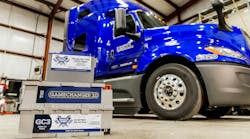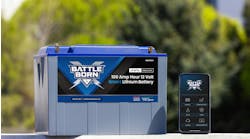Velociti Instant ROI program available for Battle Born All-Electric APU
NEW ORLEANS—With technology always improving and offering new ways to make trucks more efficient, it can be difficult for fleets to get the capital necessary to make all the upgrades that could reduce operating expenses. All too often, “it takes money to make money,” as the financial idiom goes.
Due to a new partnership between Velociti and Dragonfly Energy announced at the 2024 TMC Annual Meeting, that doesn’t have to be true. Dragonfly’s Battle Born lithium-ion All Electric APU is now part of Velociti's Instant ROI and VeloCare programs, allowing fleets to integrate the APU onto their tractors and start making payments for both the technology and its installation after the integration is complete. Payments could extend from 12-36 months, though fleets get the benefits of the electric APU from day one.
The companies say this allows fleets to stay cash positive and ultimately could save them millions due to reduced fuel costs and maintenance, as well as offer lower emissions and quieter operation.
“The ease of working with a single provider for deployment and support needs means fleets will have a more streamlined and comprehensive approach to reduce their environmental impact and provide increased driver comfort that can lead to improved driver retention,” said Wade Seaburg, chief revenue officer at Dragonfly Energy.
According to Dragonfly and Velociti, buying the Battleborn APU through the Instant ROI program provides instant fuel and maintenance savings. Even though the All Electric APU costs more than other anti-idling equipment, it uses far less diesel. For example, an engine auto start/stop and bunk heater solution may cost $2,000, versus the $8,500 Battle Born APU, but over four years requires more than 10,000 gallons annually for rest-period idling versus 672 gallons for the Battle Born APU. The extra fuel usage strains the engine and aftertreatment system more as well, accounting for an extra $4,000 in maintenance costs. All told, this APU would be about one-fourth the cost of an engine auto start/stop and bunk heater.
Against a diesel APU, the APU is 38% of the cost, and half the cost of a hybrid APU.
In one example, Velociti showed that swapping out an existing AGM battery system for the APU on 1,000 tractors would save a fleet $2.25 million over 36 months. Each tractor would save $300 per month over that time, while the financing would start after 5 months and cost $265/month for 30 months.
How the install works
“We start by managing the technology installation, the project management piece itself—which is one of the big obstructions keeping fleets from being able to adopt technology,” said Deryk Powell, president of Velociti. “They're busy hauling freight and it's difficult for them to figure out 'How do we get ahold of these assets?'”
Velociti mobile technicians then drive out to the trucks and perform the roughly five-hour install. Through Velociti’s VeloCare program, the maintenance provider then offers tech support and health monitoring throughout the APU's life. A replacement parts allowance and on-site repairs are also included in the bundled finance agreement.
Dragonfly, which also offers individual Battle Born batteries, has a warranty rate of under 0.5%.
“There's no maintenance with our batteries,” Seaburg said. “There's a lot of engineering that goes into it upfront and a lot of failure mode analysis.”
And if a failure does occur, Velociti will send out a repair tech through the VeloCare program. All this ensures the fleet can focus on deliveries and that the driver’s downtime won’t be interrupted.
“You're going to get more uptime, because you're not going to be replacing batteries, and you're going to have better driver satisfaction, because [they’re] going to have less interruptions to [their] sleep,” Seaburg said.




